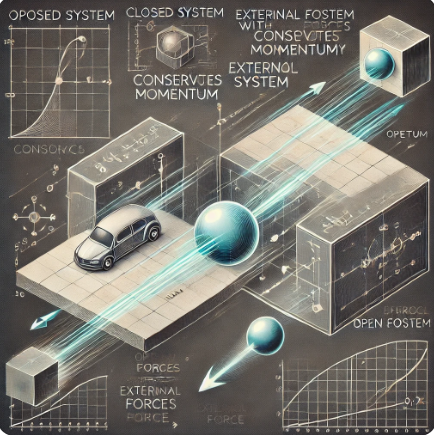Closed Systems vs. Open Systems
A closed system refers to a system that does not lose mass, energy, charge, or other conserved quantities. In such systems, these conserved properties remain constant over time. Conversely, an open system interacts with its surroundings, exchanging energy, charge, or other properties, which may lead to apparent changes in those quantities.
In open systems, momentum can appear to change as external interactions influence the system. However, these changes are due to exchanges with the environment, not a violation of conservation laws. Understanding the differences between closed and open systems is essential for analyzing momentum accurately.
Key Points About Closed and Open Systems
Closed Systems: The total momentum of all objects within the system is conserved. The total momentum before and after an interaction remains constant.
Open Systems: Momentum may not appear conserved because the system exchanges momentum with external objects. To analyze such systems, you must account for all external interactions.
In open systems, total momentum is calculated by considering both internal system interactions and external forces acting on the system.
Example: A car (closed system) retains constant momentum unless acted upon by external forces such as friction or air resistance. However, if it exchanges energy with the environment (open system), momentum will appear to change.
Momentum of a System
The momentum of a system depends on the internal and external forces acting upon it. Internal forces, such as those within an object or system, occur in action-reaction pairs and cancel each other out, as described by Newton’s Third Law. Therefore, internal forces do not contribute to changes in the net momentum of a closed system.
External Forces and Momentum
The net momentum of a system changes only when an external force acts upon it. If the net external force is zero, the system’s momentum remains conserved:
This conservation applies to the net momentum of the entire system, not individual objects within the system.
Example Problems
Example Problem #1:
A car of mass 1000 kg is traveling at a velocity of 50 m/s. The car has a passenger of mass 75 kg traveling with it. What is the total momentum of the car and the passenger?
Solution:
Momentum of the car:
Momentum of the passenger:
Total momentum:
Example Problem #2:
A spaceship of mass 1000 kg is traveling at a velocity of 50 m/s. The spaceship has a cargo of mass 500 kg traveling with it. The cargo has a velocity of 25 m/s relative to the spaceship. What is the total momentum of the spaceship and the cargo?
Solution:
Momentum of the spaceship:
Momentum of the cargo:
Total momentum:
Example Problem #3:
A train of mass 10,000 kg is traveling at a velocity of 50 m/s. The train has 20 cars, each with a mass of 1000 kg and a velocity of 50 m/s. What is the total momentum of the train and its cars?
Solution:
Momentum of the train engine:
Momentum of the 20 cars:
Total momentum:
Key Takeaways
In closed systems, momentum is conserved, and total momentum remains constant in the absence of external forces.
Open systems interact with the environment, and momentum changes must account for these external exchanges.
Use the principle of conservation of momentum to solve problems, especially for interactions like collisions and separations.
By understanding the distinction between open and closed systems and applying the principles of conservation, you can tackle complex momentum problems with confidence.







